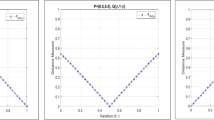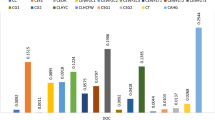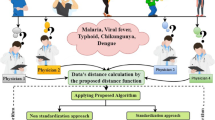Abstract
Pythagorean fuzzy set is a notion that takes a broader view at intuitionistic fuzzy set with a higher prospect of applications since it has a wider scope compared to IFS. On the other hand, distance measure is an efficient information measure for decision-making via deep learning approach, and thus, this paper proposes a new tri-parametric distance and its weighted version under Pythagorean fuzzy environment with improved performance indexes compared to the hitherto tri-parametric distance measures in the literature. The proposed Pythagorean fuzzy-based distance operators are new approaches because they take into account the three conventional number of parameters of PFSs against the existing practice, and as well incorporate the whole parameters to avoid error due to exclusion as witnessed in other distance operators. Some theorems are presented to validate the new Pythagorean fuzzy distance techniques with regards to its alignment with distance operator’s properties. We demonstrate the applications of the proposed Pythagorean fuzzy distance and its weighted version in cases involving pattern classification and disease diagnosis via deep learning approach where patterns, diseases and patients are presented as Pythagorean fuzzy values. Finally, some comparative analyses of the new tri-parametric Pythagorean fuzzy distance and its weighted version alongside some similar existing distances are presented in terms of the applications to showcase the superiority of the present Pythagorean fuzzy distance techniques.
Similar content being viewed by others
Explore related subjects
Discover the latest articles, news and stories from top researchers in related subjects.Data availability
This paper has no associated data.
References
Zadeh LA (1965) Fuzzy sets. Inf Control 8:338–353
Atanassov KT (1986) Intuitionistic fuzzy sets. Fuzzy Set Syst 20:87–96
Atanassov KT (1989) Geometrical interpretation of the elements of the intuitionistic fuzzy objects. Preprint IM-MFAIS-1-89, Sofia
Yager RR (2013) Pythagorean membership grades in multicriteria decision making. Technical Report MII-3301 Machine Intelligence Institute, Iona College, New Rochelle, NY
Yager RR, Abbasov AM (2013) Pythagorean membership grades, complex numbers and decision making. Int J Intell Syst 28(5):436–452
Boran FE, Akay D (2014) A biparametric similarity measure on intuitionistic fuzzy sets with applications to pattern recognition. Inf Sci 255(10):45–57
Chen SM, Chang CH (2015) A novel similarity measure between Atanassov’s intuitionistic fuzzy sets based on transformation techniques with applications to pattern recognition. Inf Sci 291:96–114
Szmidt E, Kacprzyk J (2001) Intuitionistic fuzzy sets in some medical applications. Note IFS 7(4):58–64
Atanassov KT (1999) Intuitionistic fuzzy sets: theory and applications. Physica-Verlag, Heidelberg
Wang W, Xin X (2005) Distance measure between intuitionistic fuzzy sets. Pattern Recog Lett 26:2063–2069
Hatzimichailidis AG, Papakostas AG, Kaburlasos VG (2012) A novel distance measure of intuitionistic fuzzy sets and its application to pattern recognition problems. Int J Intell Syst 27:396–409
Liu P, Chen SM (2017) Group decision making based on Heronian aggregation operators of intuitionistic fuzzy numbers. IEEE Trans Cybern 47(9):2514–2530
Burillo P, Bustince H (1996) Entropy on intuitionistic fuzzy sets and on interval-valued fuzzy sets. Fuzzy Set Syst 78:305–315
Szmidt E, Kacprzyk J (2000) Distances between intuitionistic fuzzy sets. Fuzzy Set Syst 114:505–518
Davvaz B, Sadrabadi EH (2016) An application of intuitionistic fuzzy sets in medicine. Int J Biomath 9(3):1650037
Du YQ, Hou F, Zafar W, Yu Q, Zhai Y (2017) A novel method for multiattribute decision making with interval-valued Pythagorean fuzzy linguistic information. Int J Intell Syst 32(10):1085–1112
Garg H (2016) A new generalized Pythagorean fuzzy information aggregation using Einstein operations and its application to decision making. Int J Intell Syst 31(9):886–920
Garg H (2017) Generalized Pythagorean fuzzy geometric aggregation operators using Einstein t-norm and t-conorm for multicriteria decision making process. Int J Intell Syst 32(6):597–630
Garg H (2018) Linguistic Pythagorean fuzzy sets and its applications in multiattribute decision making process. Int J Intell Syst 33(6):1234–1263
Liang D, Xu Z (2017) The new extension of TOPSIS method for multiple criteria decision making with hesitant Pythagorean fuzzy fets. Appl Soft Comput 60:167–179
Ejegwa PA, Wen S, Feng Y, Zhang W, Liu J (2022) A three-way Pythagorean fuzzy correlation coefficient approach and its applications in deciding some real-life problems. Appl Intell. https://doi.org/10.1007/s10489-022-03415-5
Ejegwa PA, Wen S, Feng Y, Zhang W, Chen J (2021) Some new Pythagorean fuzzy correlation techniques via statistical viewpoint with applications to decision-making problems. J Intell Fuzzy Syst 40(5):9873–9886
Ejegwa PA, Wen S, Feng Y, Zhang W (2021) Determination of pattern recognition problems based on a Pythagorean fuzzy correlation measure from statistical viewpoint. In: Proc 13th int conf advanced comput intell. Wanzhou, China, pp 132–139
Zhang XL, Xu ZS (2014) Extension of TOPSIS to multiple criteria decision making with Pythagorean fuzzy sets. Int J Intell Syst 29:1061–1078
Ejegwa PA, Jana C, Pal M (2022) Medical diagnostic process based on modified composite relation on Pythagorean fuzzy multisets. Granul Comput 7:15–23
Ejegwa PA, Onyeke IC (2022) Some new distance and similarity algorithms for Pythagorean fuzzy sets with application in decision-making problems. In: Broumi S (ed.), Handbook of research on advances and applications of fuzzy sets and logic, pp 192–211, Hershey, Pennsylvania 17033–1240, USA
Peng X, Yuan H, Yang Y (2017) Pythagorean fuzzy information measures and their applications. Int J Intell Syst 32:991–1029
Peng X (2019) New similarity measure and distance measure for Pythagorean fuzzy set. Complex Intell Syst 5(2):101–111
Meng L, Wei X (2021) Research on evaluation of sustainable development of new urbanization from the perspective of urban agglomeration under the Pythagorean fuzzy sets. Discret Dyn Nat Soc. https://doi.org/10.1155/2021/2445025
Wan Z, Shi M, Yang F, Zhu G (2021) A novel Pythagorean group decision-making method based on evidence theory and interactive power averaging operator. Complexity. https://doi.org/10.1155/2021/9964422
Zulqarnain RM, Siddique I, Jarad F, Hamed YS, Abualnaja KM, Iampan A (2022) Einstein aggregation operators for Pythagorean fuzzy soft sets with their application in multiattribute group decision-making. J Funct Spaces. https://doi.org/10.1155/2022/1358675
Saeed M, Ahmad MR, Rahman AU (2022) Refined Pythagorean fuzzy sets: properties, set-theoretic operations and axiomatic results. J Comput Cogn Eng. https://doi.org/10.47852/bonviewJCCE2023512225
Akram M, Zahid K, Alcantud JCR (2022) A new outranking method for multicriteria decision making with complex Pythagorean fuzzy information. Neural Comput Appl 34:8069–8102
Ye J, Chen TY (2022) Pythagorean fuzzy sets combined with the PROMETHEE method for the selection of cotton woven fabric. J Nat Fibers. https://doi.org/10.1080/15440478.2022.2072993
Li DQ, Zeng WY (2018) Distance measure of Pythagorean fuzzy sets. Int J Intell Syst 33:348–361
Ejegwa PA (2020) Distance and similarity measures for Pythagorean fuzzy sets. Granul Comput 5(2):225–238
Diamond P, Kloeden P (1994) Metric spaces of fuzzy sets theory and applications. Word Scientific, Singapore
Ejegwa PA (2020) Modified Zhang and Xu’s Distance measure of Pythagorean fuzzy sets and its application to pattern recognition problems. Neural Comput Appl 32(14):10199–10208
Zeng W, Li D, Yin Q (2018) Distance and similarity measures of Pythagorean fuzzy sets and their applications to multiple criteria group decision making. Int J Intell Syst 33(11):2236–2254
Ejegwa PA, Awolola JA (2021) Novel distance measures for Pythagorean fuzzy sets with applications to pattern recognition problems. Granul Comput 6:181–189
Hussain Z, Yang MS (2019) Distance and similarity measures of Pythagorean fuzzy sets based on the Hausdorff metric with application to fuzzy TOPSIS. Int J Intell Syst 34(10):2633–2654
Xiao F, Ding W (2019) Divergence measure of Pythagorean fuzzy sets and its application in medical diagnosis. Appl Soft Comput 79:254–267
Mahanta J, Panda S (2021) Distance measure for Pythagorean fuzzy sets with varied applications. Neural Comput Appl 33:17161–17171
Sarabu A, Santra AK (2021) Human action recognition in videos using convolution long short-term memory network with Spatio-temporal networks. Emerg Sci J 5(1):25–33
Bagherzadeh SHZ, Toosizadeh S (2022) Eye tracking algorithm based on multi model Kalman filter. High Tech Innov J 3(1):15–27
Funding
This work is supported by Foundation of Chongqing Municipal Key Laboratory of Institutions of Higher Education ([2017]3), Foundation of Chongqing Development and Reform Commission (2017[1007]), and Foundation of Chongqing Three Gorges University.
Author information
Authors and Affiliations
Contributions
All authors contribute equally to this paper.
Corresponding author
Ethics declarations
Conflict of interest
The authors declare that they have no competing interests.
Ethical approval
Non applicable.
Informed consent
Yes.
Additional information
Publisher's Note
Springer Nature remains neutral with regard to jurisdictional claims in published maps and institutional affiliations.
Rights and permissions
Springer Nature or its licensor holds exclusive rights to this article under a publishing agreement with the author(s) or other rightsholder(s); author self-archiving of the accepted manuscript version of this article is solely governed by the terms of such publishing agreement and applicable law.
About this article
Cite this article
Ejegwa, P.A., Feng, Y., Tang, S. et al. New Pythagorean fuzzy-based distance operators and their applications in pattern classification and disease diagnostic analysis. Neural Comput & Applic 35, 10083–10095 (2023). https://doi.org/10.1007/s00521-022-07679-3
Received:
Accepted:
Published:
Issue Date:
DOI: https://doi.org/10.1007/s00521-022-07679-3




